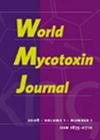Aflatoxin contamination in maize: occurrence and health implications in Latin America
IF 1.7
4区 医学
Q3 FOOD SCIENCE & TECHNOLOGY
引用次数: 3
Abstract
According to the United Nations Food and Agriculture Organisation, mycotoxicoses constitute the second most pressing food safety problem worldwide, with most cases occurring in developing countries. Maize (Zea mays L.), the main staple for many Latin Americans, is one of the best suitable substrates for mycotoxigenic Aspergillus fungi. Aflatoxins (AFs) produced primarily by Aspergillus flavus, are of significant concern, especially in developing countries. While AFs production occurs mainly in warmer, tropical, and subtropical environments, recent evidence suggests that global climate change favours their presence in regions with little or no awareness of this issue. AFs interfere with metabolic processes, causing cancer and other health disorders resulting in health hazards and even death. The setting of national acceptable regulatory levels of AFs is necessary for Latin American countries. Unfortunately, no estimates of the economic impact of AFs in this region are currently available nor the cost of regulatory programs designed to reduce health risks to animals and humans. This review explores relevant data about incidence of AFs in maize produced in the region and the adverse effects of the consumption of contaminated foods and the associated health consequences for Latin American consumers. Regulations aimed to mitigate AFs exposure to consumers are also reviewed and identified gaps for researchers and actors of the maize value chain are also proposed.拉丁美洲玉米中黄曲霉毒素污染的发生及其对健康的影响
根据联合国粮农组织(United Nations Food and Agriculture Organisation)的数据,真菌中毒是全球第二大紧迫的食品安全问题,大多数病例发生在发展中国家。玉米(Zea mays L.)是许多拉丁美洲人的主食,是产霉毒素曲霉真菌最适合的底物之一。黄曲霉毒素(AFs)主要由黄曲霉(Aspergillus flavus)产生,尤其在发展中国家引起严重关注。虽然AFs的生产主要发生在温暖的热带和亚热带环境中,但最近的证据表明,全球气候变化有利于它们在很少或没有意识到这一问题的地区存在。AFs干扰代谢过程,导致癌症和其他健康失调,导致健康危害甚至死亡。拉丁美洲国家有必要制定国家可接受的AFs管理水平。不幸的是,目前没有关于非洲猪瘟对该地区经济影响的估计,也没有旨在减少动物和人类健康风险的监管计划的成本。本综述探讨了有关该区域生产的玉米中AFs发病率的相关数据,以及食用受污染食品的不利影响和对拉丁美洲消费者的相关健康后果。还审查了旨在减轻消费者对AFs风险的法规,并为研究人员和玉米价值链参与者提出了空白建议。
本文章由计算机程序翻译,如有差异,请以英文原文为准。
求助全文
约1分钟内获得全文
求助全文
来源期刊

World Mycotoxin Journal
MYCOLOGY-
CiteScore
4.60
自引率
5.00%
发文量
25
审稿时长
>12 weeks
期刊介绍:
''World Mycotoxin Journal'' is a peer-reviewed scientific journal with only one specific area of focus: the promotion of the science of mycotoxins. The journal contains original research papers and critical reviews in all areas dealing with mycotoxins, together with opinions, a calendar of forthcoming mycotoxin-related events and book reviews. The journal takes a multidisciplinary approach, and it focuses on a broad spectrum of issues, including toxicology, risk assessment, worldwide occurrence, modelling and prediction of toxin formation, genomics, molecular biology for control of mycotoxigenic fungi, pre-and post-harvest prevention and control, sampling, analytical methodology and quality assurance, food technology, economics and regulatory issues. ''World Mycotoxin Journal'' is intended to serve the needs of researchers and professionals from the scientific community and industry, as well as of policy makers and regulators.
 求助内容:
求助内容: 应助结果提醒方式:
应助结果提醒方式:


